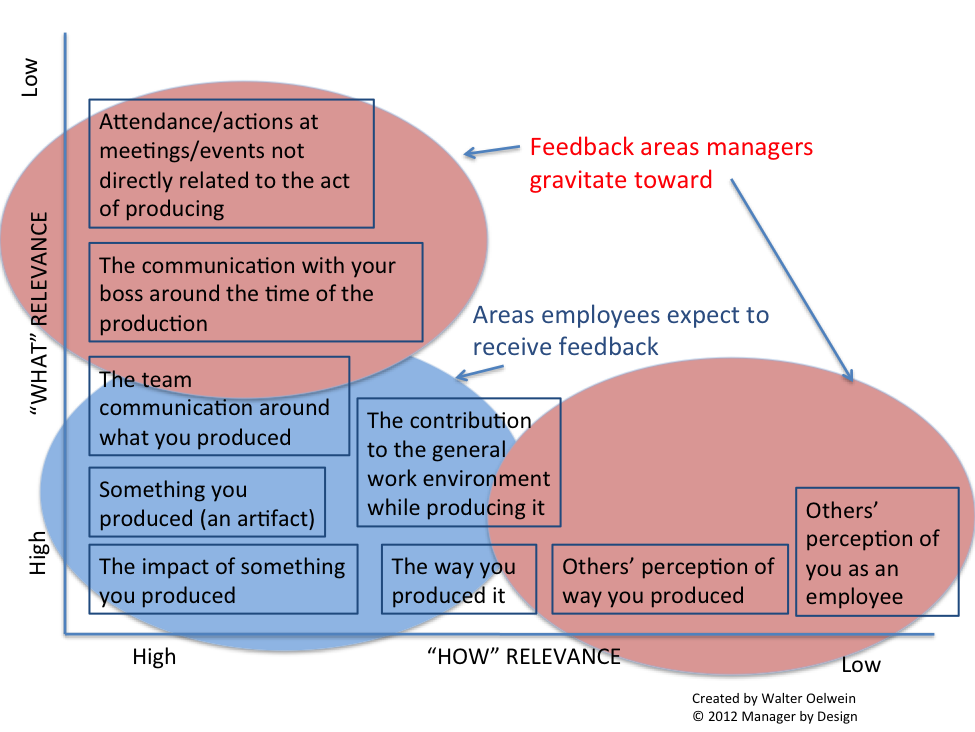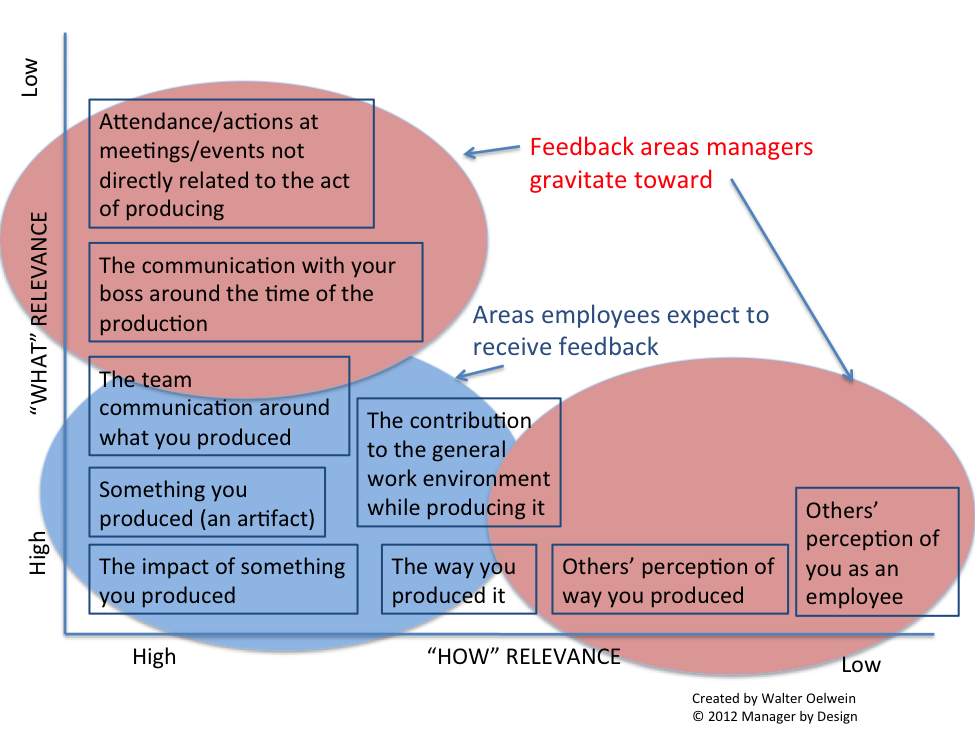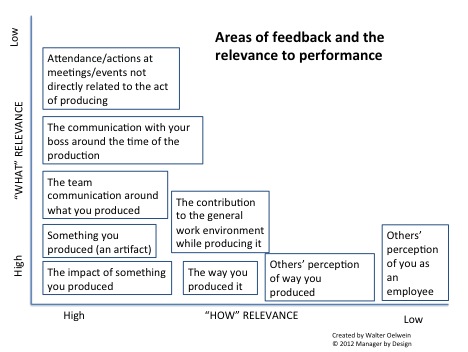Using perceptions to manage: Three reasons why this messes things up
Today I start a series of articles on managers using perceptions to manage. A common way that managers attempt to do this is to use perceptions as a way of giving performance feedback and starting conversations with “There’s a perception that. . .” This is an indicator that the manager is attempting to manage perceptions. Here’s what I mean:
Have you ever had a manager give you feedback that starts with the words, “There’s a perception that. . .”? It may sound like this:
“There’s a perception that you aren’t delivering.”
“There’s a perception that you aren’t keeping up.”
“There’s a perception that you’re always late.”
“There’s a perception that you aren’t a team player.”
Managers who use the phrase, “There’s a perception that . . .” are attempting to manage perceptions. Here are the reasons that the phrase, “There’s a perception that. . .” need to be removed from a manager’s vocabulary and the effort to manage perceptions need to be refocused to other pursuits:
1. This may be feedback, but it isn’t Performance Feedback.
Managers attempt to manage perceptions via giving feedback on the perceptions. Using perceptions as the basis for feedback means that the feedback is on a phantom job external to the actual job. The performance of the employee — what the employee has actually done — has been removed from the feedback. The new implication is that the employee needs to manage perceptions in addition to doing the job. By giving this feedback, the manager has actually removed the duties of doing the actual job, and has inadvertently assigned new, and presumably more important duties to the employee: manage perceptions.
A tool for how to tell if feedback is relevant to your job
Many employees suffer though poorly given feedback by their manager. But sometimes it is hard to figure out exactly why it is poor feedback. One reason that feedback given by a manager is often poor – even if it is specific, immediate and behavior-based (markers of good feedback) — is that it is not entirely relevant to the employee’s job.
Oh, the feedback from your may seem relevant, because it is job-related. But it isn’t really job related. To help explain, I created this model of the areas managers have been known to give feedback on.
You’ll see in the model that there are a lot of areas that managers can give feedback on. So one would hope that a manager would be judicious and be focused on the areas most relevant to the employee’s work and the impact of that work.
However, as the circles show, managers often default to more extraneous areas of job performance, such as perceptions of others and behaviors in meetings that are indirect (at best) to job outcomes. Read more
A second phantom job many employees have: Managing perceptions of others
In my previous article, I shared a model to determine the relevance of the performance aspect of performance feedback that many managers give to employees. Here’s the model:
In looking at the upper left corner of this model, many managers create, via the act of giving performance feedback, a second job for the employee: How the employee performs in front of the boss.
So now the employee has two jobs: 1. The job and 2. The job of performing in front of your boss.
The model reveals also in the lower left corner that when a manager gives performance feedback, a third job is often created:
3. The job of managing the perception of others in how you perform your job. Read more
A model to determine if performance feedback is relevant to job performance
In my previous article, I discussed a common mistake managers make: They evaluate the “interactions with the boss” performance, and not the “doing your job performance.” So an employee can go through an entire year and not receive performance feedback on the work he was ostensibly hired to do, but receive lots of performance feedback on how he interacts with his boss.
Given this concept of receiving feedback on the job performance vs. receiving feedback on the “in front of the boss” performance, let’s create a model to help managers get closer to the actual performance of an individual, and where the performance feedback needs to be.
Here is a grid that looks at various elements that employees commonly receive “performance feedback” on. I put these elements into boxes along the “what/how” grid, with the most relevant to job performance being toward the lower left, and the least relevant up and to the right.
In looking at this grid, you can see that what is most relevant is the impact of something produced, with the next most relevant elements being the actual thing you produced, and the way you produced it. Finally, the contribution to the general environment and the communication around the thing produced is the next most relevant element. The closer to the lower left, the closer it is it performance.
Performance feedback must be related to a performance
Have you ever received performance feedback about what you say and do in a 1:1 meeting?
Have you ever received performance feedback about your contributions to a team meeting?
Have you ever received performance feedback about not attending a team event or party?
Were you frustrated about this? I would be. Here’s why:
The performance feedback is about your interactions with your manager and not about what you are doing on the job. This is an all-too-common phenomenon.
If you are getting feedback about items external to your job expectations, but not external to your relationship with your boss, you aren’t receiving performance feedback. You’re receiving feedback on how you interact with your boss. The “performance” that is important is deferred/differed from your job performance, and into a new zone of performance – your “performance in front of your boss.”
OK, so now you have two jobs. 1. Your job and 2. Your “performance in front of your boss.”
Tenets of management design: If you can’t break down a job into its tasks and workflows, find someone who can
Today I discuss a key element to managing well: Knowing what your team members are supposed to do.
This is part of a continuing series that explores the tenets of Management Design, the field this blog pioneers. Management Design is a response to the poorly performing existing designs that are currently used in creating managers. These current designs describe how managers tend to be created by accident or anointment, rather than by design.
Today’s tenet: If you can’t break down a job into its tasks and workflows, find someone who can.
Many managers are expected to manage a team of people, but really don’t have the clarity as to what the team members are expected to do. Managers often have a sense of what their customers want, and what some examples of things the team produces, or metrics that indicate success (such as sales).
But these are, for the most part, results or indicators of what the team does, not what the team does. The manager should have an understanding of what the component tasks are for the team members’ roles, and when added up, equals the thing that is produced, which then generate the metrics or impressions of success of the team.
Tenets of management design: Doing managerial tasks is what adds up to being a manager
In today’s article, I discuss the meaning of what it means to be a manager. This is part of a continuing series that explores the tenets of Management Design, the field this blog pioneers. Management Design is a response to the poorly performing existing designs that are currently used in creating managers. These current designs describe how managers tend to be created by accident, rather than by design, or that efforts to develop quality and effective managers fall short.
Today’s tenet: Doing managerial tasks is what adds up to being a manager.
The current understanding of what it means to be a manager is to receive the designation of “manager.” If someone gets a role as “manager”, they are now a manager. Notice that the new manager does not have to perform any managerial tasks to get this designation. This explains why many managers can “be a manager” without actually doing anything managerial (see my series on manager identity). That manager can perform any number of things that are not managerial (continuing to do the individual contributor work, for example), and still be the manager. That manager can do things that are the exact opposite of good management practices (such as yelling or making generalizations about employees, for example), and still be considered a manager by virtue of being designated the manager.
A common identity of a manager is the ability to rise in the organization – and is this a good thing?
I’ve recently been writing about how the act of becoming a manager is an act that destroys the personal work identity of that new manager. The manager no longer gets to do what they were good at as an individual contributor (IC), and now they are doing something they are new at – and perhaps in an awkward and amateurish way. So the identity of being good at the former job is lost, and the ability to do the new job of management is slow to develop – if ever.
However, there is one aspect the new manager’s identity that is quickly formed via the act of becoming a manager. That is: The ability to “rise” through the ranks.
This is a differentiation that the others individual contributors (IC) in the organization do not have. Only the manager has demonstrated this “skill.” So while the new manager may lose his ability to perform the IC job, is no longer an expert at the IC job, and suffers through suddenly being amateurish at his job, the manager is indisputably good at one thing: Getting promoted into the manager ranks.
Manager by Design 2011 Year in Review: Top Article Series (part 2)
As we close out the year, here are the top series of articles published by Manager by Design in 2011. See part 1 here.
Team Strategy Documents
Think of managing a team as a set of deliverables
Teams should have a team strategy document. Here’s an example.
How to create a team strategy document—use the team
How to use your team strategy document externally
How to use the team strategy document to help you manage your team
Creating a system that encourages good management
An obsession with talent could be a sign of a lack of obsession with the system
Tenets of Management Design: Managers are created not found
Tenet of management design: If you don’t have a system, it’s probably being done over email
All-team meetings (and why they’re hard to do well)
Do your all-team meetings make your team cringe?
Reasons many employees dread all-team meetings
Quick tips for making all-hands meetings tolerable and useful
The annual review reveals more about the manager’s performance than the employee’s performance
Let’s look at what a well-conducted annual review looks like
Five more markers and examples of what a good annual review looks like
Annual reviews are awesome artifacts that can be used to improve management skills
“You don’t take feedback well” – and its ramifications
Telling someone they “don’t take feedback well” doesn’t count as performance feedback
Three more reasons “You don’t take feedback well” is risky performance feedback
A Performance Feedback/Performance Management Flowchart
Becoming a manager – and the havoc it wreaks on one’s identity in the workplace
Becoming a manager is a subversion of self-identity
Without management design, the new manager relies on base instincts
The new manager is an amateur at doing managerial tasks
Giving performance feedback is breaks the illusion of greatness of a manager
Why managers don’t give performance feedback – it hurts the ego
Manager by Design 2011 Year in Review: Top Article Series (part 1)
As we close out the year, here are the top series of articles published by Manager by Design in 2011. Enjoy and thanks to all who support the Manager by Design blog!
Areas where providing feedback is most useful
What inputs should a manager provide performance feedback on?
When to provide performance feedback using direct observation: Practice sessions
When to provide performance feedback using direct observation: On the job
Areas of focus in providing performance feedback based on direct observation: Tangible artifacts
What managers can do about “intangible human-based artifacts”
Giving feedback based on indirect sources (and how difficult this really is)
Three reasons why giving performance feedback based on indirect information doesn’t work
Bonus! Six more reasons why giving performance feedback based on indirect information is risky
Tips for how managers should use indirect sources of information about employees
What to do when you receive a customer complaint about your employee’s performance
Using strategy sessions with employees (as opposed to just “feedback”)
Manager of Manager providing feedback to and about employees (and the difficulty it brings)
What a manager can do if the big boss puts a tag on an employee
More reasons the big boss’s feedback on an employee is useless
On the inherent absurdity of stack ranking and the angst it produces in employees
An obsession with talent could be a sign of a lack of obsession with the system
How to maximize the value of peer feedback
Why peer feedback from surveys doesn’t qualify as feedback
Examples of how peer feedback from surveys is misused by managers
How to use peer feedback from surveys for good (it’s not easy) Part 1
How to use peer feedback from surveys for good (it’s not easy) – Part 2
Some pros and cons of peer feedback directly given by peers
An opportunity to increase the amount of performance feedback on your team
Tips for how a manager can improve direct peer feedback
Bonus! Three more tips for how manager can improve direct peer feedback
How managers receive (or don’t receive) feedback on managing
Managers giving managers feedback on managing: How well is this done?
Management Design: How managers receive performance feedback compared to other jobs
Entry level jobs receive a lot of performance feedback: What about managers?
How about managers ask for feedback from their employees?
Specific phrases and examples for how to ask for feedback from your employees
One more option for providing feedback to manager: 3rd Party Assessment and Coaching
How do employees give feedback to their manager?
How to give feedback to your manager: Some possible openings




